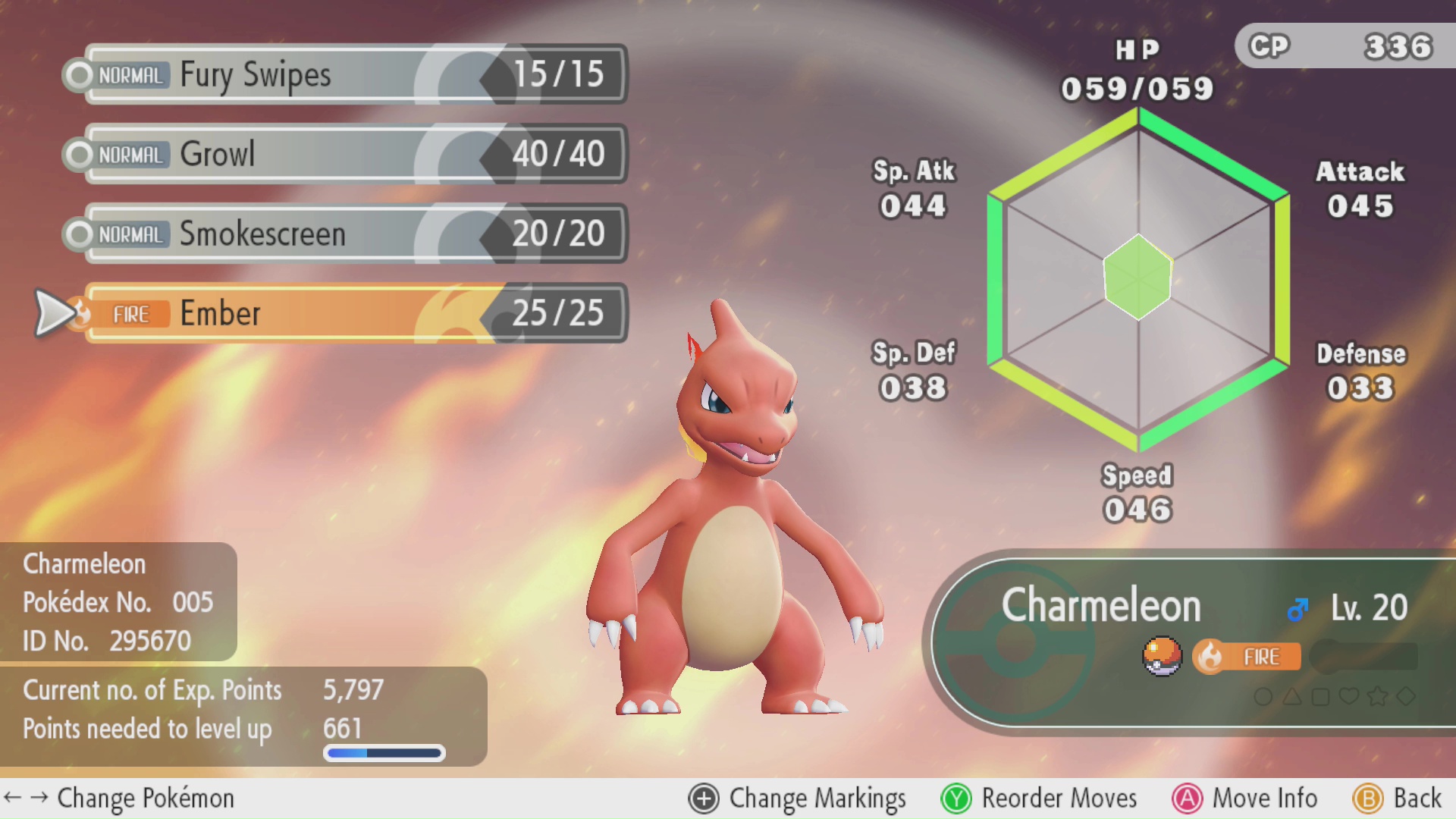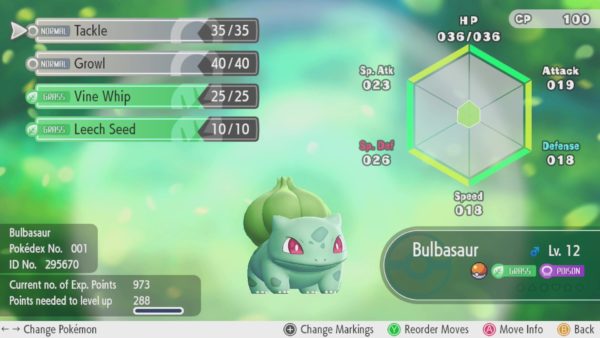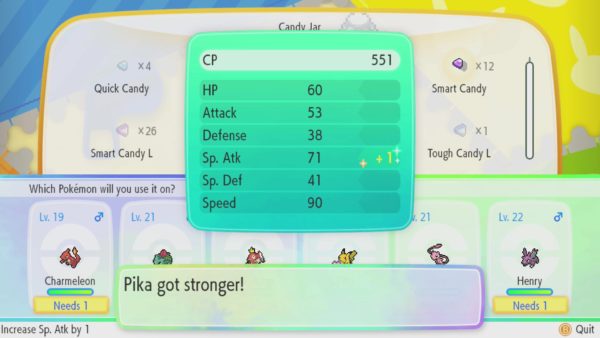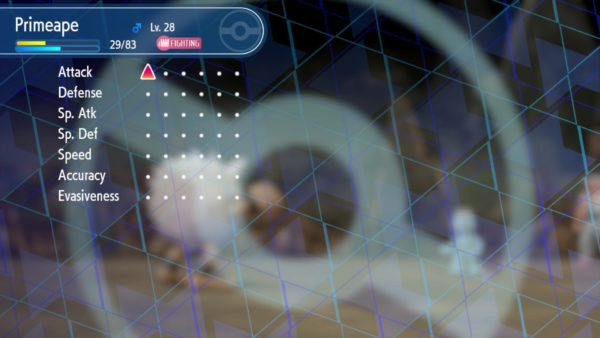Every Pokemon’s strengths and weaknesses are determined by six stats: hit points (HP), attack, defense, special attack, special defense, and speed. Pay close attention to these stats to bring out the full potential of your Pokemon. It might seem like a lot at first, but you don’t have to learn everything unless you want to get competitive. First let’s discuss the six different types of stats in Pokemon:
- HP is the base stat that determines the hit points of a Pokemon. Hit points are the numbers used to determine the amount of health each Pokemon has until they faint. When Pokemon get hit by an attack, their HP decreases.
- Attack is the base stat that determines the physical power of a Pokemon. Moves such as body slam will rely on the attack stat for the amount of damage it deals to an opponent.
- Defense is the base stat that determines how much damage a Pokemon can resist from physical attacks.
- Special attack is the base stat that determines the special power of your Pokemon. Moves such as Flamethrower will rely on the special attack stat for the damage it deals to an opponent.
- Special defense is the base stat that determines how much damage a Pokemon can resist from special attacks.
- Speed is the base stat that determines when a Pokemon will strike in battle. Since Pokemon battles are turn based, speed determines if your Pokemon will attack first or last. This may not be a huge deal in Single Battles, but when it’s a double battle, one of the Pokemon will attack fourth! Make Note: Some moves — like Quick Attack — will strike first even if a Pokemon has a lower speed stat than their opponent. Likewise, moves like Avalanche may strike last every time. If both Pokemon in the battle use one of these types of moves during the same turn, the speed stat will determine who strikes first.
Base Stats, IVs, and Candies
In Pokemon Let’s Go Pikachu and Let’s Go Eevee, there are three variations of these six stats to make each and every Pokemon unique.
First are the base stats. Every species of Pokemon has a predetermined set of stats. This means every Pikachu in LGP and LGE will have the same base stats, and every Eevee will have the same base stats. It’s best to look at these stats first before training your Pokemon. You wouldn’t want to train a Kadabra in attack because it has a naturally weak attack stat and naturally great special attack stat.
| Pokemon | HP | Attack | Defense | Sp. Attack | Sp. Defense | Speed |
|---|---|---|---|---|---|---|
| Pikachu | 35 | 55 | 40 | 50 | 50 | 90 |
| Eevee | 55 | 55 | 50 | 45 | 65 | 55 |
| Kadabra | 40 | 35 | 30 | 120 | 70 | 105 |
| Machoke | 80 | 100 | 70 | 50 | 60 | 45 |
Next up are the stats commonly called individual values (IVs) or determined values. Every Pokemon has a set of randomly assigned stats once they are captured or received as a gift. The partner Pokemon, Pikachu and Eevee, will always have maxed out individual values. Similarly, Pokemon received as gifts often have very high or partially maxed out individual values. However, all wild Pokemon will have randomly generated IVs. Build catch combos to find Pokemon with better stats more often. The tiers are Not So Good, OK, Good, Very Good, Fantastic, and Best.
Only competitive Trainers pay attention to these stats. In fact, these stats cannot be seen until the Judge feature is added to your Pokemon’s summary. This is a reward from Professor Oak’s Aide in the house between Routes 11 and 12 for capturing 30 different species of Pokemon. The Stats shown in the Judge feature can be one to three stars with a summary of OK, Good, Great, and Amazing!
The final type is being called awakening values (AVs). These are the stat increases earned each time a Pokemon levels up or eats some candies in Let’s Go Pikachu and Let’s Go Eevee. That is the reason why wild or newly captured Pokemon are always weaker than trained Pokemon.
Pokemon can be chained together with Catch Combos to increase the candies you receive after a wild encounter. The easiest Pokemon to chain for candies and where they can be found in the wild are listed in the table below.
| Stat | Candy | Pokemon | Locations |
|---|---|---|---|
| HP | Health | Caterpie | Viridian Forest, Route 2 |
| Attack | Mighty | Goldeen | Route 6 |
| Attack | Mighty | Machop, Machoke | Rock Tunnel, Victory Road |
| Defense | Tough | Geodude, Graveler | Mt. Moon, Rock Tunnel, Victory Road |
| Sp. Attack | Smart | Ghastly, Haunter | Pokemon Tower |
| Sp. Attack | Smart | Psyduck | Routes 24 and 25 |
| Sp. Defense | Courage | Tentacool | Routes 4, 24, 10, 11, 12, 18, 19, 20, 21 (most routes with water) |
| Sp. Defense | Courage | Venonat | Routes 24 and 25 |
| Speed | Quick | Rattata, Pidgey | Most routes with tall grass |
| Speed | Quick | Zubat, Golbat | Mt. Moon, Rock Tunnel, Victory Road |
At first, one candy will increase a Pokemon’s stat by one point; but as the stat builds up, it will take even more candies to increase the stat by one point. The amount of candies needed depends on the individual Pokemon. Eventually, you will need 20 candies just to increase a stat by one level. Once a stat reaches a certain limit in Awakening Values, you will be forced to use a different kind of Candy (L, XL, and Species). A stat can have a max of 200 awakening values. See the candies page for more info.
Battle Stats
Two other stats can also be found in-game, but only during battle. For that reason, they’re commonly known as battle stats. Those two stats are evasiveness and accuracy. Instead of being part of a Pokemon’s own stats, they are tied to the Pokemon’s moves. Some attacks are very precise, while others are best used after applying accuracy boosts.
Accuracy is the stat that determines the ability to hit a Pokemon. All moves have an accuracy stat which ranges from 100% to 30%. The lesser accurate moves are usually much more powerful. Some moves — such as Aerial Ace — will always hit no matter what your Pokemon’s accuracy is!
Evasiveness is the stat that determines the ability of a Pokemon to dodge an attack. A Pokemon’s evasiveness can be increased or decreased in battle to evade a Pokemon’s moves, just like if you were to lower an opponent Pokemon’s accuracy.
Stat Modifications
While in battle, all stats (except HP) can be increased and decreased with certain attacks. Each stat can be increased up to six times or decreased up to six times. If one Pokemon’s stat is increased to the max, it can then be reduced up to twelve times to reach the bare minimum. Base stats and battle stat modifications are a bit different from each other.
Base Stat Modifications
Base stats can be increased or decreased a max of six stages with stat altering moves or items. Some stat changing moves can alter a Pokemon’s stats two stages at a time, meaning they only have to be used three times instead of six.
The following tables showcase the increases and decreases made to base stats. Say an attack does 50 points of damage. If you increase a stat that affects that damage by three stages, you will increase the damage by 150%, adding 75 points to the 50 points of damage, making it a total of 125 damage. Some people find it easier to use damage multipliers by multiplying 50 by 2.5x to get 125 damage, so those are included as well.
| Stages | Percentage | Multiplier |
|---|---|---|
| 1st | 50% | 1.5x |
| 2nd | 100% | 2x |
| 3rd | 150% | 2.5x |
| 4th | 200% | 3x |
| 5th | 250% | 3.5x |
| 6th | 300% | 4x |
| Stages | Percentage | Multiplier |
|---|---|---|
| 1st | 33.3% | .666x |
| 2nd | 50% | .50x |
| 3rd | 60% | .4x |
| 4th | 66.6% | .333x |
| 5th | 71.5% | .285x |
| 6th | 75% | .25x |
Battle Stat Modifications
Unlike base stats, accuracy and evasiveness changes have slightly different values. The principles are the same, and you can increase or decrease the stats by six stages, but the percentage they’re increased or decreased by is slightly altered.
| Stages | Percentage | Multiplier |
|---|---|---|
| 1st | 33% | 1.33x |
| 2nd | 66% | 1.66x |
| 3rd | 100% | 2x |
| 4th | 133% | 2.33x |
| 5th | 166% | 2.66x |
| 6th | 200% | 3x |
| Stages | Percentage | Multiplier |
|---|---|---|
| 1st | 25% | .75x |
| 2nd | 40% | .6x |
| 3rd | 50% | .5x |
| 4th | 57.2% | .428x |
| 5th | 62.5% | .375x |
| 6th | 66% | .33x |






